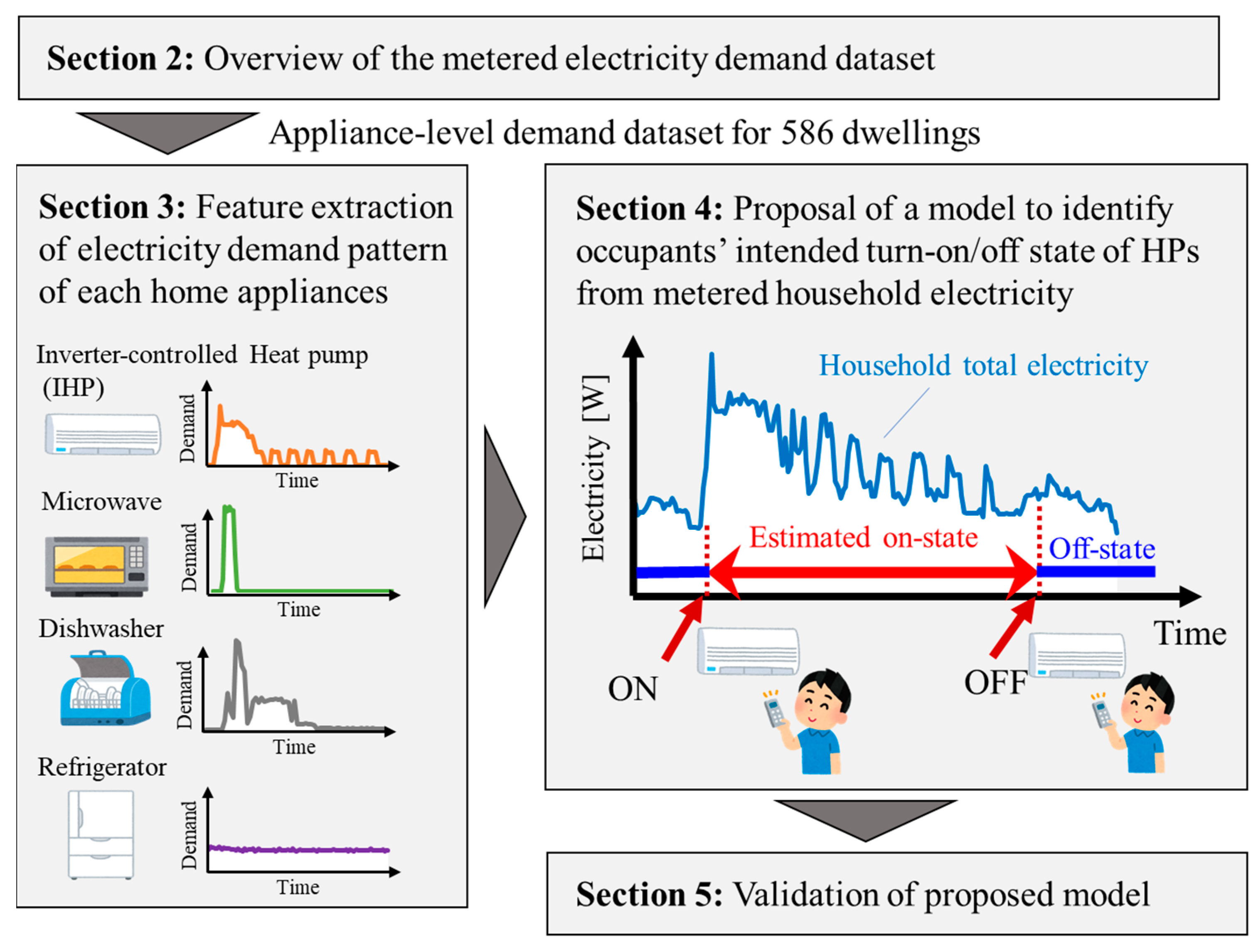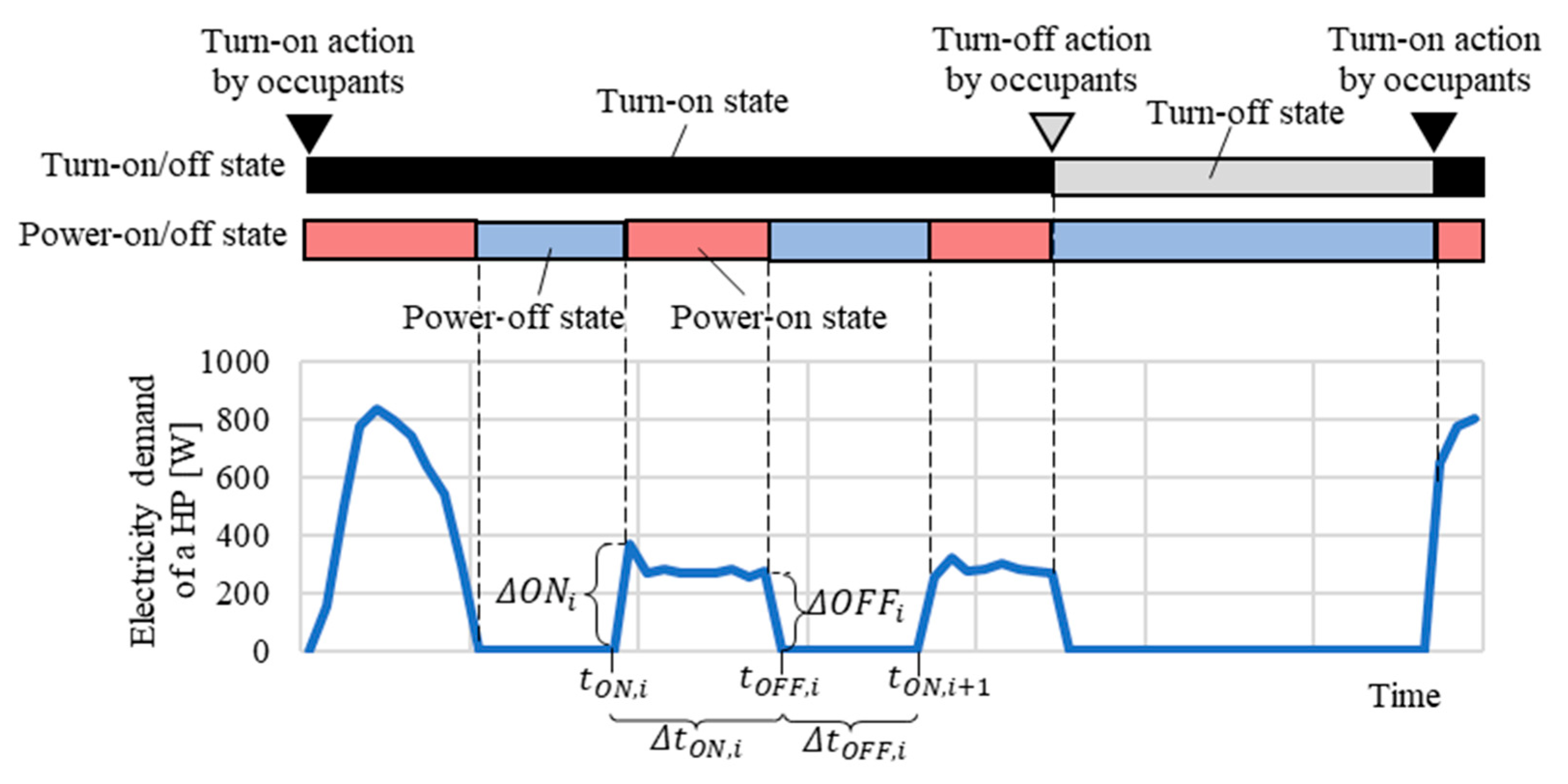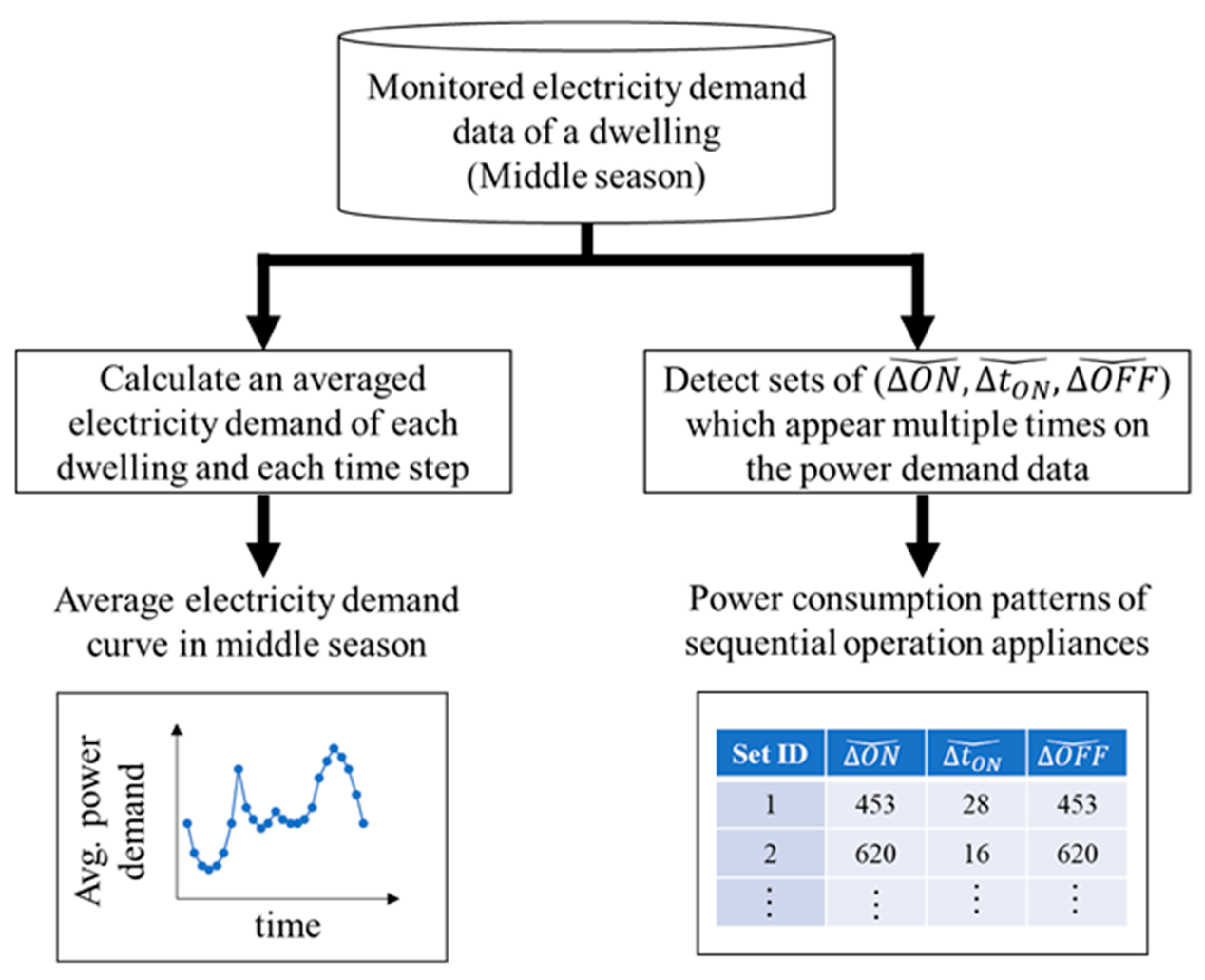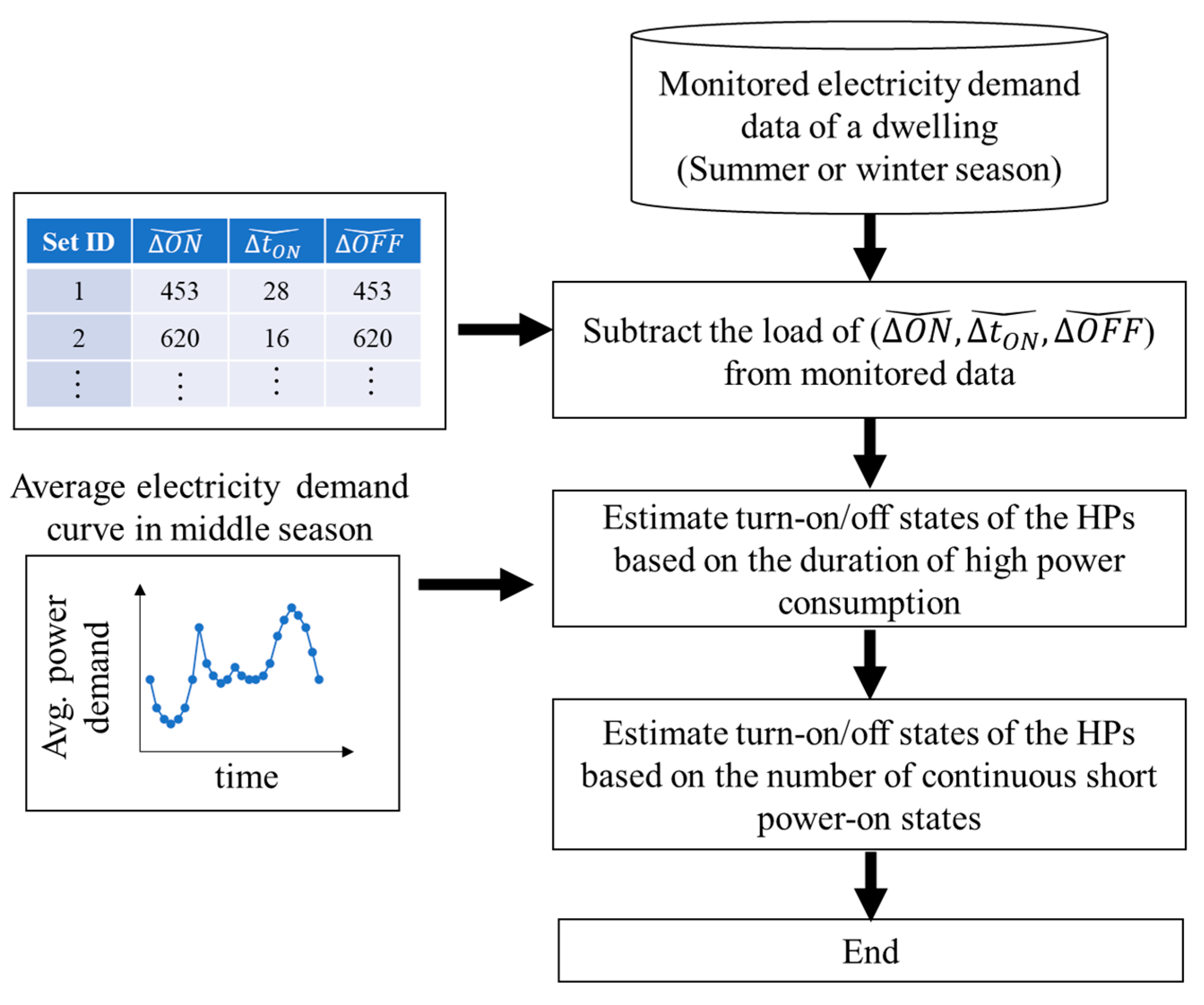Non-Intrusive Detection of Occupants’ On/Off Behaviours of Residential Air Conditioning
Abstract
1. Introduction
2. Summary of Dataset
2.1. Target Dwellings
2.2. Breakdown of Electricity Demand by Use
2.3. Electricity Demand Patterns of IHPs
3. Characteristics of Electricity Consumption Pattern
3.1. Variables to Characterise the Load Patterns
3.2. Time-Series Characteristics of Electricity Consumption of Appliances
4. Proposed Method to Detect Turn-On/Off State of HPs
4.1. Outline of the Proposed Method
- Pre-process: Based on the pre-acquired total electricity demand data of a dwelling in the middle season, the time-series characteristics of the power consumption patterns of sequential operation appliances other than HPs were extracted. In addition, the power consumption baseline for the dwellings was determined. (Section 4.2).
- Detection: The electricity consumption corresponding to the sequential operation appliances, except for HPs, was subtracted from the measured total household electricity consumption (Section 4.3.1). Subsequently, the turn-on/off states of the HPs were estimated based on the duration of high-power consumption (Section 4.3.2) and time-series characteristics (Section 4.3.3).
4.2. Pre-Processing Based on Electricity Consumption Data in Middle Season
4.3. Detection of Turn-On/Off State of HPs
4.3.1. Subtraction of Power Consumption of Sequential Operation Appliances except for HPs
4.3.2. Detection Based on the Duration of High-Power Consumption
4.3.3. Detection Based on Time-Series Characteristics
5. Validation of the Proposed Model
5.1. Data Used for Validation
5.2. Time Sequence of Estimated On/Off State
5.3. Performance Metrics of the Proposed Model
6. Conclusions
- The power consumption patterns of HPs currently used in many countries are characterised by intermittent power-on/off operation, depending on the intensity of the room heating and cooling load, owing to the inverter control. To quantify such features of IHPs different from other home appliances, three indicators (Δ, Δ, Δ) are defined.
- The proposed method entails two steps: (1) pre-processing to determine the baseline demand for the mid-season and extract time-series characteristics of the power consumption patterns of sequential operation appliances, and (2) a detection process using the baseline demand and the abovementioned three indicators.
- The performance of the proposed model was validated using data measured from 423 dwellings. The F-scores, precision, and recall showed performance better than those in the previous study.
Author Contributions
Funding
Institutional Review Board Statement
Informed Consent Statement
Data Availability Statement
Acknowledgments
Conflicts of Interest
References
- United Nations Environment Programme. Global Status Report for Buildings and Construction: Towards a Zero Emission, Efficient and Resilient Buildings and Construction; United Nations Environment Programme: Nairobi, Kenya, 2021; Volume 2021. [Google Scholar]
- González-Torres, M.; Pérez-Lombard, L.; Coronel, J.F.; Maestre, I.R.; Yan, D. A review on buildings energy information: Trends, end-uses, fuels and drivers. Energy Rep. 2022, 8, 626–637. [Google Scholar] [CrossRef]
- Ono, T.; Hagishima, A.; Tanimoto, J.; Zaki, S.A.; Hisham, N.A. Statistical analysis of air conditioning peak loads of multiple dwellings. In Proceedings of the 13th REHVA World Congress CLIMA, Bucharest, Romania, 26 May 2019. [Google Scholar]
- Lyu, J.; Ono, T.; Sato, A.; Hagishima, A.; Tanimoto, J. Seasonal variation of residential cooling use behaviour derived from energy demand data and stochastic building energy simulation. J. Build. Eng. 2022, 49, 104067. [Google Scholar] [CrossRef]
- International Energy Agency. Net Zero by 2050—A Road Map for the Global Energy Sector. 2021. Available online: https://iea.blob.core.windows.net/assets/deebef5d-0c34-4539-9d0c-10b13d840027/NetZeroby2050-ARoadmapfortheGlobalEnergySector_CORR.pdf (accessed on 9 September 2022).
- Kobus, C.B.A.; Klaassen, E.A.M.; Mugge, R.; Schoormans, J.P.L. A real-life assessment on the effect of smart appliances for shifting households’ electricity demand. Appl. Energy 2015, 147, 335–343. [Google Scholar] [CrossRef]
- Paterakis, N.G.; Erdinc, O.; Bakirtzis, A.G.; Catalao, J.P.S. Optimal household appliances scheduling under day-ahead pricing and load-shaping demand response strategies. IEEE Trans. Ind. Inform. 2015, 11, 1509–1519. [Google Scholar] [CrossRef]
- Yan, X.; Ozturk, Y.; Hu, Z.; Song, Y. A review on price-driven residential demand response. Renew. Sustain. Energy Rev. 2018, 96, 411–419. [Google Scholar] [CrossRef]
- Muratori, M.; Rizzoni, G. Residential demand response: Dynamic energy management and time-varying electricity pricing. IEEE Trans. Power Syst. 2015, 31, 1108–1117. [Google Scholar] [CrossRef]
- Saele, H.; Grande, O.S. Demand response from household customers: Experiences from a pilot study in Norway. IEEE Trans. Smart Grid 2011, 2, 102–109. [Google Scholar] [CrossRef]
- Schleich, J.; Faure, C.; Klobasa, M. Persistence of the effects of providing feedback alongside smart metering devices on household electricity demand. Energy Policy 2017, 107, 225–233. [Google Scholar] [CrossRef]
- Nilsson, A.; Wester, M.; Lazarevicac, D.; Brandt, N. Smart Homes, Home Energy Management Systems and Real-Time Feedback: Lessons for Influencing Household Energy Consumption from a Swedish Field Study. J. Build. Eng. 2022, 49. Available online: https://www.sciencedirect.com/science/article/abs/pii/S0378778818311691 (accessed on 9 September 2022). [CrossRef]
- Martinez, K.; Donnelly, K.; Laitner, J. Advanced metering initiatives and residential feedback programs: A meta-review for household electricity-saving opportunities. In Proceedings of the Washington, DC: American Council for an Energy-Efficient Economy, Washington, DC, USA, 23 February 2010; Technical Report; Research Reports. Volume E105. [Google Scholar]
- Hart, G.W. Nonintrusive appliance load monitoring. Proc. IEEE 1992, 80, 1870–1891. [Google Scholar] [CrossRef]
- Zeifman, M.; Roth, K. Nonintrusive appliance load monitoring: Review and outlook. IEEE Trans. Con. Electron. 2011, 57, 76–84. [Google Scholar] [CrossRef]
- Leeb, S.B.; Shaw, S.R.; Kirtley, J.L. Transient Event Detection in spectral envelope estimates for nonintrusive load monitoring. IEEE Trans. Power Deliv. 1995, 10, 1200–1210. [Google Scholar] [CrossRef]
- Murata, H.; Onoda, T.; Yoshimoto, K.; Nakano, Y. Comparison of machine learning techniques for estimating the power consumption of household electric appliances. IEEJ Trans. Electron. Inf. Syst. 2003, 123, 1350–1355. [Google Scholar] [CrossRef]
- Kolter, J.; Johnson, M. REDD: A public data set for energy disaggregation research. In Proceedings of the 1st KDD Workshop on Data Mining Applications in Sustainability, San Diego, CA, USA, 21 August 2011. [Google Scholar]
- Kelly, J.; Knottenbelt, W. UK-DALE: A dataset recording UK domestic appliance-level electricity demand and whole-house demand. Sci. Data 2015, 2, 150007. [Google Scholar] [CrossRef] [PubMed]
- Kolter, J.; Batra, S.; Ng, A. Energy disaggregation via discriminative sparse coding. Neural Inf. Process. Syst. 2010, 23, 1153–1161. [Google Scholar]
- Kim, H.; Marwah, M.; Arlitt, M.; Lyon, G.; Han, J. Unsupervised disaggregation of low frequency power measurements. In Proceedings of the SIAM Conference on Data Mining, Mesa, AZ, USA, 28 April 2011. [Google Scholar]
- Parson, O.; Ghosh, S.; Weal, M.; Rogers, A. An unsupervised training method for non-intrusive appliance load monitoring. Artif. Intell. 2014, 217, 1–19. [Google Scholar] [CrossRef]
- Basu, K.; Debusschere, V.; Douzal-Chouakria, A.D.; Bacha, S. Time series distance-based methods for non-intrusive load monitoring in residential buildings. Energy Build. 2015, 96, 109–117. [Google Scholar] [CrossRef]
- Kim, J.; Le, T.T.H.; Kim, H. Nonintrusive load monitoring based on advanced deep learning and novel signature. Comp. Intell. Neurosci. 2017, 2017, 4216281. [Google Scholar] [CrossRef]
- Gomes, E.; Pereira, L. PB-NILM: Pinball guided deep non-intrusive load monitoring. IEEE Access 2020, 8, 48386–48398. [Google Scholar] [CrossRef]
- Fujita, M.; Fujimoto, Y.; Hayashi, Y. Nonintrusive monitoring of electrical appliance load via restricted Boltzmann machine with temporal reservoir. In Proceedings of the 12th the International Conference on Agents and Artificial Intelligence, Valletta, Malta, 22–24 February 2020; pp. 902–909. [Google Scholar]
- Inoue, H.; Ishiyama, F.; Watanabe, T.; Ohyama, T. Operating State Estimation of Electric Appliances Based on Power-Time-Series at a Distribution Board. IEICE Tech. Rep. 2015, 114, 19–22. [Google Scholar]
- Perez, K.X.; Cole, W.J.; Rhodes, J.D.; Ondeck, A.; Webber, M.; Baldea, M.; Edgar, T.F. Nonintrusive disaggregation of residential air-conditioning loads from sub-hourly smart meter data. Energy Build. 2014, 81, 316–325. [Google Scholar] [CrossRef]
- Rhodes, J.D.; Upshaw, C.R.; Harris, C.B.; Meehan, C.M.; Walling, D.A.; Navrátil, P.A.; Beck, A.L.; Nagasawa, K.; Fares, R.L.; Cole, W.J.; et al. Experimental and data collection methods for a large-scale smart grid deployment: Methods and first results. Energy 2014, 65, 462–471. [Google Scholar] [CrossRef]
- Su, S.; Yan, Y.; Lu, H.; Kangping, L.; Yujing, S.; Fei, W.; Liming, L.; Hui, R. Non-intrusive load monitoring of air conditioning using low-resolution smart meter data. In Proceedings of the IEEE international conference on power system technology, Wollongong, NSW, Australia, 28 September 2016. [Google Scholar]
- Pahasa, J.; Potejana, P.; Ngamroo, I. Multi-objective decentralized model predictive control for inverter air conditioner control of indoor temperature and frequency stabilization in microgrid. Energies 2021, 14, 6969. [Google Scholar] [CrossRef]
- Song, M.; Gao, C.; Yan, H.; Yang, J. Thermal battery modeling of inverter air conditioning for demand response. IEEE Trans. Smart Grid 2018, 9, 5522–5534. [Google Scholar] [CrossRef]
- Hui, H.; Ding, Y.; Lin, Z.; Siano, P.; Song, Y. Capacity allocation and optimal control of inverter air conditioners considering area control error in multi-area power systems. IEEE Trans. Power Syst. 2020, 35, 332–345. [Google Scholar] [CrossRef]
- Nezhada, A.E.; Rahimnejadb, A.; Gadsden, S.A. Home energy management system for smart buildings with inverter-based air conditioning system. Int. J. Electr. Power Energy Syst. 2021, 133, 107230. [Google Scholar] [CrossRef]
- Chen, Z.; Shi, J.; Song, Z.; Yang, W.; Zhang, Z. Genetic algorithm based temperature-queuing method for aggregated IAC load control. Energies 2022, 15, 535. [Google Scholar] [CrossRef]
- Ono, T.; Hagishima, A.; Tanimoto, J. Development and Validation of Algorithm to Distinguish ON/OFF State of Household Air Conditioners on the Basis of Time-Series Data of Electricity Consumption. Trans. Soc. Heat. Air-Cond. Sanit. Eng. Japan 2018, 43, 37–45. Available online: https://www.jstage.jst.go.jp/article/shase/43/255/43_37/_article/-char/en (accessed on 9 September 2022).















| Location | Settsu City, Osaka, Japan |
| Number of stories | 20 |
| Completion date | January 2011 |
| Structure | Reinforced concrete structure |
| Building envelopes | External walls: internal insulation with air layer, U-value 0.411 W/(m2 K) Windows: Low-E double-glazing |
| Number of dwellings by layout (average floor area) | Total 586 dwellings 38 dwellings: 2 bedrooms + LDK a (55.1 m2) 391 dwellings: 3 bedrooms + LDK a (71.2 m2) 157 dwellings: 4 bedrooms + LDK a (83.6 m2) |
| Room Floor Area [m2] | Cooling Capacity [kW] | Heating Capacity [kW] | Annual Performance Factor |
|---|---|---|---|
| 18 | 2.8 (0.6–4.2) | 3.2 (0.6–7.9) * | 6.7 |
| 26 | 4.0 (0.6–5.4) | 5.0 (0.6–10.4) * | 6.3 |
| 33 | 5.0 (0.6–5.9) | 6.0 (0.6–10.4) * | 5.7 |
| 36 | 6.3 (0.6–6.5) | 7.1 (0.6–10.4) * | 5.1 |
| 42 | 7.1 (0.6–7.3) | 7.5 (0.6–10.4) * | 4.7 |
| F-Score | Precision | Recall | |
|---|---|---|---|
| Inoue et al. [25] | 0.667 | 0.708 | 0.708 |
| Proposed method | 0.834 | 0.820 | 0.847 |
Publisher’s Note: MDPI stays neutral with regard to jurisdictional claims in published maps and institutional affiliations. |
© 2022 by the authors. Licensee MDPI, Basel, Switzerland. This article is an open access article distributed under the terms and conditions of the Creative Commons Attribution (CC BY) license (https://creativecommons.org/licenses/by/4.0/).
Share and Cite
Ono, T.; Hagishima, A.; Tanimoto, J. Non-Intrusive Detection of Occupants’ On/Off Behaviours of Residential Air Conditioning. Sustainability 2022, 14, 14863. https://doi.org/10.3390/su142214863
Ono T, Hagishima A, Tanimoto J. Non-Intrusive Detection of Occupants’ On/Off Behaviours of Residential Air Conditioning. Sustainability. 2022; 14(22):14863. https://doi.org/10.3390/su142214863
Chicago/Turabian StyleOno, Tetsushi, Aya Hagishima, and Jun Tanimoto. 2022. "Non-Intrusive Detection of Occupants’ On/Off Behaviours of Residential Air Conditioning" Sustainability 14, no. 22: 14863. https://doi.org/10.3390/su142214863
APA StyleOno, T., Hagishima, A., & Tanimoto, J. (2022). Non-Intrusive Detection of Occupants’ On/Off Behaviours of Residential Air Conditioning. Sustainability, 14(22), 14863. https://doi.org/10.3390/su142214863







